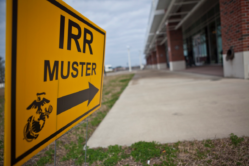In a previous article, I wrote about the decision to either take terminal leave or sell it back. Basically, it boils down to the opportunity costs—what are you going to do with that terminal leave if you choose to take it? Personal reasons aside (like taking a well-deserved break), if you have nothing better to do with your leave, then you’re better off financially just selling it. In this article, we’ll discuss 3 ways you can make the most of your terminal leave.
1. Pull as much to the left as possible.
There are a lot of things that you just cannot do before a certain point. For example, your VA disability claim cannot be filed until you reach 180 days prior to your separation or retirement.
However, there is a LOT that you can do, well before you start terminal leave. For example, if you’re starting your own business, you can work on your business plan. If you’re going back to school, you can take whatever test you need (SAT, GRE, GMAT, etc.) and start your applications. If you are planning to get a job, you can always make more professional connections. For example, you can increase your online presence by improving your LinkedIn profile. If you plan to stay in your local community, you can join a professional organization or take up a volunteer opportunity in your area.
Pulling administrative items to the left as much as you can will free up your time so you can focus more on the things that really matter. For example, as a financial planner, my business plan originally called for my registration and state filings to be done during my terminal leave. However, once my CFP® and enrolled agent exams were complete (other items I pulled to the left), I revised my business plan. My new plan called for me to start my business ‘on the side’ while finishing my last tour.
It’s fortunate that I did so since my Form ADV took 4 months for the state of Florida to approve (due to no fault of my own). Waiting until my terminal leave to file the paperwork would have kept me on the sidelines, wasting my terminal leave. Instead, I’ve been working with clients and have a steady flow of appointments that should keep me busy during that time.
Here are some examples of other things you can pull to the left:
- Taking your Transition GPS (formerly known as TAP) class.
- Taking workshops offered through your local transition office. There are small business workshops, educational programs, and civil service employment workshops, among others.
- Going to employer job fairs
- Documenting your medical issues/concerns (if you plan to file a disability claim)
- Registrations, certifications, or exams
- Working on your resume and practicing for interviews
2. Have a multi-faceted plan.
You should have a plan that covers multiple aspects of your life. Many people are very good at planning for one thing, such as preparing for their next duty station. However, leaving the military actually involves more moving parts such as:
- Replacing the income that we often take for granted
- Figuring out health care, dental, and other active-duty benefits
- Adjusting to ‘civilian life,’ specifically losing the supportive community that many people appreciate about the military
While it’s important to have a plan for post-military employment (unless you’re going back to school), it’s just as important to plan for these other things. Your plan should cover:
- Family. Your family plan should cover things like, where you’re going to live, schools, housing, etc.
- Personal finances. How long could you keep paying the bills if you don’t get a job right away? Can you pay for emergencies? If you’re retiring, what will your retirement check look like?
- Medical & dental.
- Where you’re going to live. If you’re relocating, this is definitely something you need to cover in depth.
Ideally, your multi-faceted plan should be part of an existing plan that you update annually or as significant events come up. If you’d like to know more about what this plan should cover, check out this article about building a five-year plan. Having a five-year plan in place will help you cover the activities you should be doing before your final paycheck. Additionally, it will help you anticipate the instability that you can expect as you adjust to post-military life.
3. Set a schedule for everything.
Many people I’ve talked to tell me that their terminal leave went by so quickly, they just didn’t have enough time to get everything done. When I ask them if they made a schedule, they laugh and tell me no.
Here’s how I see it. If you plan for it, you can be lucky enough to have 60-90 (or more) days of terminal leave. If you’re retiring, you might be eligible for even more time. For example, the Navy allows for 20 days of permissive TDY for job-hunting & house-hunting. We’ve all been to those retirement ceremonies where they announce the separation orders for like, 5 months from now. Well, those months are a gift. Don’t waste them.
Everyone deserves some time off. That’s what leave is for. However, not everyone can AFFORD to use up their terminal leave without getting something accomplished. This is where building a schedule comes into play.
First, take a good look at your plan, and prioritize the things that need to get done before you’re off active duty. These are things like your check-out, medical appointments, ID card appointments, etc. Build a list of these things that need to get done.
Second, if you have certain things that you have planned, schedule them. Family vacations, special trips, put them on the calendar.
Third, if you have hard deadlines, such as college enrollment, or a new job start date, schedule that as well.
Fourth, look at your plan. What hasn’t been scheduled? Can you move things around? What needs to get dropped? What can wait until later?
By taking a closer look at your plan, you can truly figure out how to make the most of your terminal leave. Remember, this is probably going to be your only opportunity to receive a full paycheck for doing whatever you want for an extended period of time. Make the most of it.
Conclusion
If you choose to take terminal leave, there is a lot that you can accomplish. During that time, the more you accomplish, the more likely you will be prepared for your post-military life.



Comments:
About the comments on this site:
These responses are not provided or commissioned by the bank advertiser. Responses have not been reviewed, approved or otherwise endorsed by the bank advertiser. It is not the bank advertiser’s responsibility to ensure all posts and/or questions are answered.
John says
I took 99 days of terminal leave and was granted 20 days of permissive TDY before I retired. Basically a 4 -month vacation!
Forrest Baumhover says
Or 4 months to get a head start on your post military life! Getting two paychecks isn’t necessarily a bad thing!